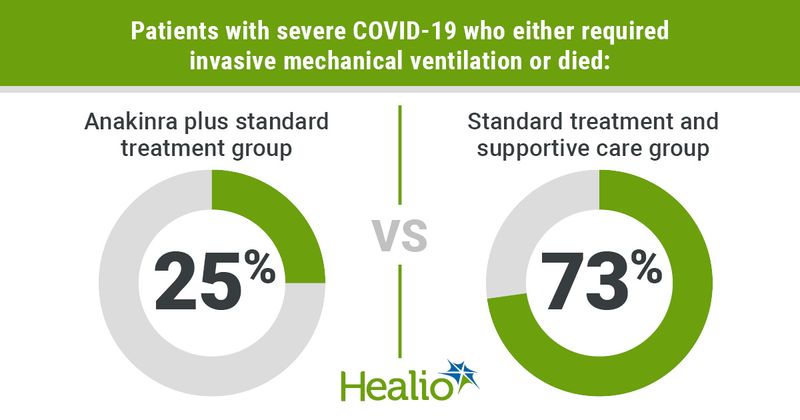Anakinra reduces ventilation need, mortality in COVID-19
Anakinra reduces the need for mechanical ventilation as well as mortality among patients with severe COVID-19, and without serious side effects, according to data published in The Lancet Rheumatology.
“SARS-CoV-2 is thought to bind to toll-like receptors, which activate the inflammasome and the cleavage of pro-IL-1 [beta] by caspase-1, followed by the production of active mature IL-1 [beta], a mediator of fever, lung inflammation, and fibrosis,” Thomas Huet, MD, of Saint Joseph’s Hospital, in Paris, and colleagues wrote. “Coronaviruses encode viroporins, which facilitate viral dissemination through their interaction with cellular ion channels. Additionally, the viroporins E and open reading frame 3a can induce transcription of the gene encoding pro-IL-1 [beta] and secretion of IL-1 [beta] by activation of the NLRP3 inflammasome.”

“Anakinra is a 17 kD recombinant, non-glycosylated human IL-1 receptor antagonist with a short half-life of about [3 to 4 hours] and good safety profile,” they added. “... These data led us to hypothesize that anakinra could represent an efficient treatment for severe forms of COVID-19, predominantly involving the inflammasome pathway.”
To examine the use of anakinra (Kineret, SOBI) among patients hospitalized with severe COVID-19 and symptoms of worsening respiratory function, Huet and colleagues conducted a retrospective cohort study of the Ana-COVID trial. According to the researchers, Ana-COVID included a prospective cohort of patients from the Saint Joseph Hospital Group in Paris, as well as a historical control group retrospectively selected from the organization’s COVID-19 cohort, established on March 18, 2020.
Inclusion criteria for the prospective cohort were age 18 years or older, admission to the Saint Joseph’s Hospital Group with severe COVID-19-related bilateral pneumonia on chest X-ray or lung CT scan, either laboratory-confirmed SARS-CoV-2 or typical lung infiltrates on a lung CT scan, and either an oxygen saturation of 93% or less under oxygen 6 L/min or more, or aggravation with a loss of 3% of oxygen saturation in ambient air over the previous 24 hours. The historical control group of patients had the same inclusion criteria. The historical control group had the same inclusion criteria.
From March 24 to April 6, 52 consecutive patients received 100 mg doses of subcutaneous anakinra twice per day for 72 hours, followed by 100 mg daily for 7 days, as well standard treatment. Additionally, 44 patients in the historical control group received standard treatment and supportive care. The primary outcome was a composite of either admission to the intensive care unit for invasive ventilation, or death. The researchers performed their primary analysis on an intention-to-treat basis.
According to the researchers, ICU admissions for invasive ventilation or death occurred in 25% of patients in the anakinra group, compared with 73% in the historical control group (HR = 0.22; 95% CI, 0.11-0.41). This impact remained significant in the multivariate analysis (HR = 0.22; 95% CI, 0.10-0.49). Regarding safety, an increase in liver aminotransferases occurred in 13% of patients who received anakinra, and in 9% of those in the historical control group.
“In severe forms of COVID-19-related pneumonia requiring oxygen therapy, a 10-day treatment with subcutaneous anakinra was associated with the reduction of both need of mechanical ventilation and mortality, as compared with a historical group with similar characteristics,” Huet and colleagues wrote. “In the context of this pandemic, with exponential curves of admittances in ICUs, the use of anakinra should be tested more extensively, preferentially through randomized trials, among patients with COVID-19 and symptoms suggesting a virus-induced cytokine storm.”


